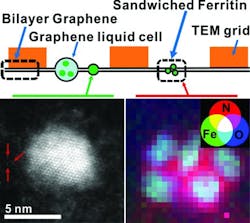Chicago, IL--Research from the University of Illinois at Chicago (UIC) published online in advance of print in Advanced Materials (see http://onlinelibrary.wiley.com/doi/10.1002/adma.201306069/abstract) describes how sandwiching a biological molecule between sheets of graphene allows the researchers to obtain atomic-level images of the molecule in its natural watery environment.
The molecule, ferritin, is a highly conserved protein that regulates the levels of iron in animals and plants. Ferritin can sequester excess iron, which can be toxic, and release it when it is needed. "We found a way to encapsulate a liquid sample in two very thin layers of graphene—sheets of carbon that are only one atom thick," said Canhui Wang, UIC graduate student in physics and first author of the study.
Electron microscopes let researchers see at the level of individual atoms. But to do so they must put the samples in a vacuum, making it impossible to image biomolecules in water in their natural, functional state. Biological samples have usually been placed in a container called a "liquid stage," wedged between relatively thick windows of silicon nitrate. Robert Klie, the senior investigator on the study, says the thin layers of graphene in the new system work better, being nearly transparent.
"It's like the difference between looking through Saran Wrap and thick crystal," said Klie, who is associate professor of physics at UIC. Not only did resolution improve, but the graphene sandwich also minimizes damage to the sample from radiation, said Wang. According to Wang, some people have calculated that just to barely visualize a sample requires the equivalent of 10 times the radiation 30 meters away from a 10 megaton hydrogen bomb. "We often use an electron beam that is several orders of magnitude more intense in our experiments," he said.
Graphene has an extraordinarily high thermal and electro-conductivity, said Klie, and is able to conduct away both the heat and the electrons generated as the electron microscope’s beam passes through the sample. Instead of using a low-energy beam to minimize damage, which yields a fuzzy picture that must be refined using a mathematical algorithm, the scientists were able to use high energies to generate images of ferritin at atomic level resolution. This enabled them to see, in a single functioning molecule, that iron oxide in ferritin's core changes its electrical charge, initiating the release of iron.
This insight into how the ferritin core handles iron may lead to a better understanding of what goes wrong in many human disorders, said Tolou Shokuhfar, assistant professor of mechanical engineering-engineering mechanics at Michigan Technological University and adjunct professor of physics at UIC, the principal investigator of the study. "Defects in ferritin are associated with many diseases and disorders, but it has not been well understood how a dysfunctional ferritin works towards triggering life-threatening diseases in the brain and other parts of the human body," said Shokuhfar.
Wang had to solve a number of technical issues to develop the new technique, said Klie, but the graphene sandwich will now "open up analysis of biological and other difficult to image samples to almost anyone with an electron microscope." In contrast, he said, the standard liquid stage requires a large upfront investment in equipment and expensive preparation of each sample. With graphene, once the technique is mastered, preparation of samples can be done quickly and cheaply, said Wang.
The work was funded by Michigan Technological University and a grant to UIC from the National Science Foundation, DMR-0959470.
SOURCE: University of Illinois at Chicago; http://news.uic.edu/graphene-sandwich-improves-imaging-of-biomolecules

Gail Overton | Senior Editor (2004-2020)
Gail has more than 30 years of engineering, marketing, product management, and editorial experience in the photonics and optical communications industry. Before joining the staff at Laser Focus World in 2004, she held many product management and product marketing roles in the fiber-optics industry, most notably at Hughes (El Segundo, CA), GTE Labs (Waltham, MA), Corning (Corning, NY), Photon Kinetics (Beaverton, OR), and Newport Corporation (Irvine, CA). During her marketing career, Gail published articles in WDM Solutions and Sensors magazine and traveled internationally to conduct product and sales training. Gail received her BS degree in physics, with an emphasis in optics, from San Diego State University in San Diego, CA in May 1986.
